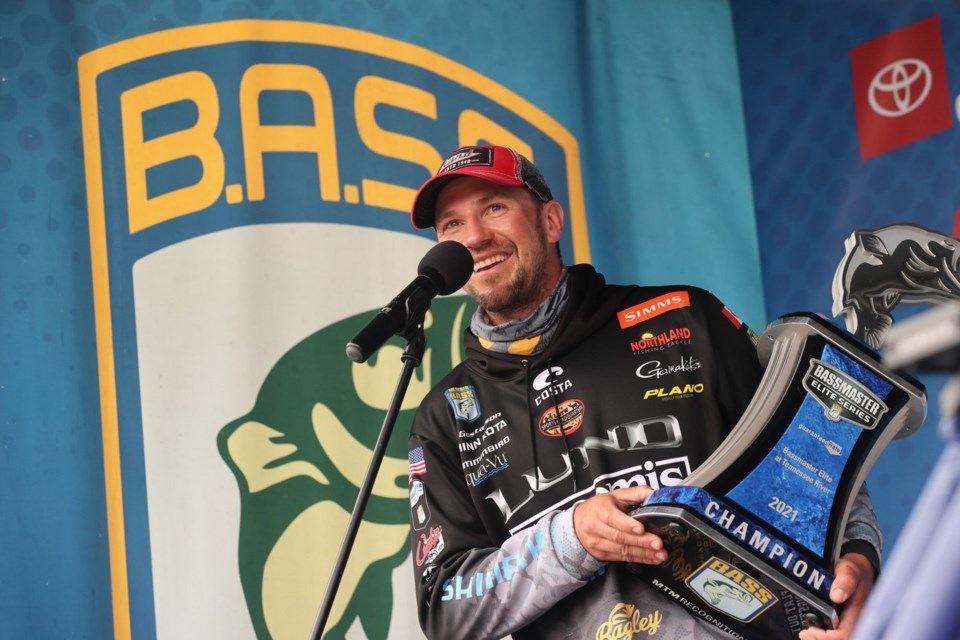They compete as individuals on the Elite Series, but professional anglers Jeff Gustafson and Cooper Gallant are teaming up to represent Canada.
Gustafson, of Kenora, Ont., and Gallant, of Bowmanville, Ont., are members of the Canadian team competing in the 2024 Pan American Black Bass tournament on New Brunswick's Saint John River.
The two-day event, which begins Friday, involves anglers from eight countries (Canada, United States, China, Colombia, Mexico, Dominican Republic, Puerto Rico and Costa Rica) and two Indigenous squads (Ontario's Turtle Island and New Brunswick's Wolastoqey Nation).
"I've never (represented Canada) so it's pretty cool," said Gustafson, who last year became the first Canadian to win the US$1-million Bassmaster Classic, pro bass fishing's premier event. "Obviously the U.S. is our primary target, they have a stacked team with a lot of the top pro anglers.
"They're going to be a handful and we're definitely going to have to bring the 'A' game to beat them."
The defending-champion U.S. features many Elite Series competitors. Its lineup includes 2024 Classic champion Justin Hamner and Trey McKinney, who finished second behind Chris Johnston of Peterborough, Ont., in the overall standings this season.
Canada won this event in 2019 when it was held in Cornwall, Ont. It finished one 100th of an ounce ahead of the Americans.
Gustafson and Gallant are two of four Canadians on the Elite Series. Johnston, and his older brother, Cory, of Cavan, Ont., are the others, with Cory Johnston winning twice on the circuit this year.
Bob Izumi is again Canada's team captain. The affable Izumi, who hosted the Real Fishing television show for nearly 40 years, is a veteran tournament competitor who also was Canada's captain in 2019.
"I wouldn't say there's extra pressure but there is pressure," Gallant said. "You want to make sure you catch them to help the team.
"You want to do the best you can, catch the most you can and contribute the most you can to try and win this thing. They (Americans) are going to be hard to beat, for sure, but it's going to be cool to see it all shakes out."
Each country will field two-man teams — to a maximum of eight — in the competition that can bring up to five fish to be weighed daily. The heaviest fish, from each nation's four best twosomes, will count toward the overall standings.
Gold, silver and bronze medals will be presented Saturday to both the top countries and individual teams.
Although they compete against each other on the Elite Series, Gustafson and Gallant have both participated in many team events and know the drill.
"We're going to try one guy staying on the screens (electronics) while the other will probably be casting a moving bait," Gustafson said. "Doing different things and if we figure out a really good program then we both may end up both doing it.
"But just try to cover as much water as we can with different tactics and techniques."
Two big differences, though, are Pan Am teams can use nets to land fish and share information. Neither is allowed on the Elite Series.
Also, cellphones can be used during the competition.
"We were at dinner exchanging information and I felt like I was doing something wrong," Gallant said with a chuckle. "That's because we're not allowed to all season, then all of a sudden we can get all the info we want.
"It's different but super cool."
The Saint John River features a solid smallmouth fishery but also has a population of largemouth bass. Traditionally, predominantly smallmouth events have favoured Canadian competitors because those fish are more prevalent north of the border.
However, with more Elite Series events centring on smallmouths and the rapid advancement of forward-facing sonar — notably Garmin's Livescope — that advantage has diminished.
'We're comfortable doing it, for sure," Gallant said. "But again so are they.
"Many of those guys are really good Livescopers and they'll figure it out either way."
Another challenge will be figuring out exactly what the fish are doing. The transition to fall can be a difficult time with many bass being in a state of flux due to changing conditions, making it hard to consistently find them.
"Every place is different," Gustafson said. "But knowing this time of the season, we caught some shallow, a few deep (during practice)," Gustafson said. "Probably the in-between stuff is the best.
"You just know they're starting to want to head for deeper water, main basin sort of thing. Again, based upon this time of year, it's trying to make your best guesses as to where you have the best shot to run into numbers of fish and bigger ones."
This report by The Canadian Press was first published Sept. 26, 2024.
Dan Ralph, The Canadian Press



